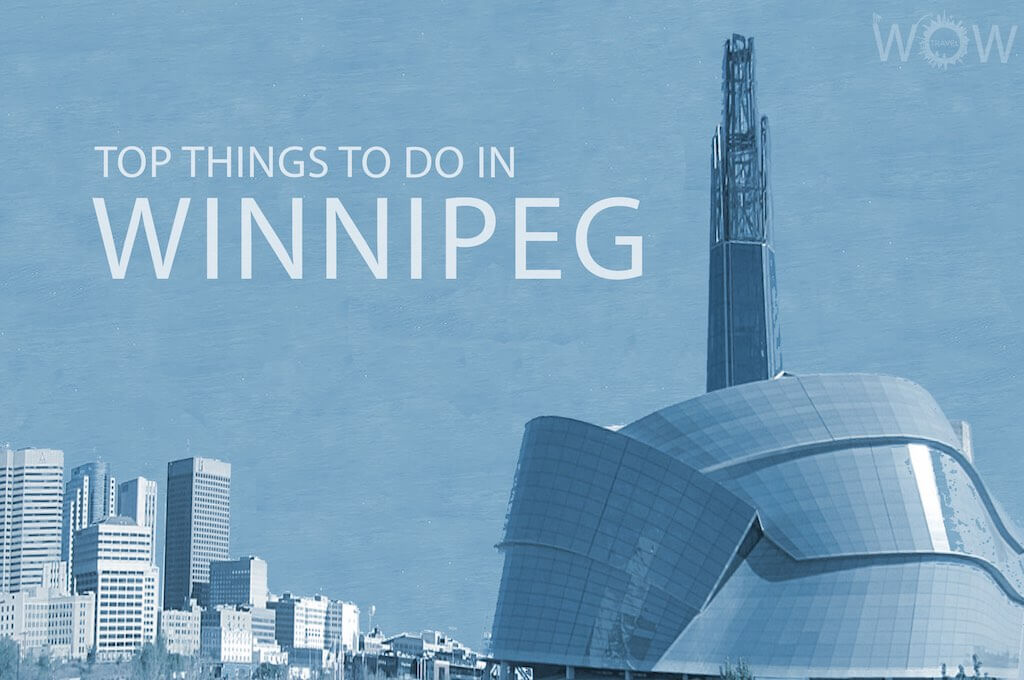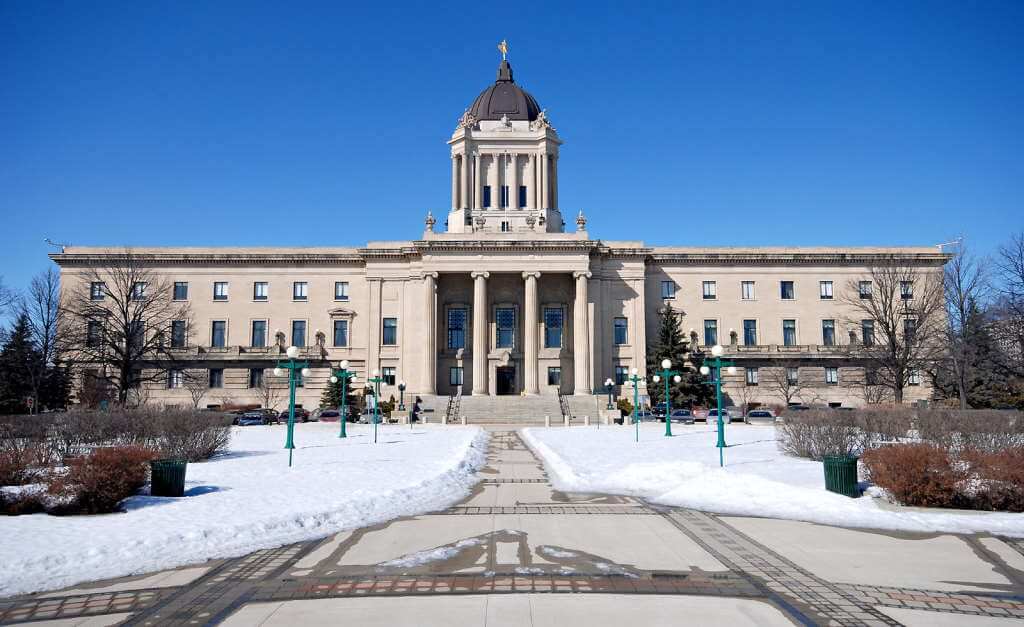Winnipeg’s strategic location at the confluence of the Assiniboine and Red Rivers, and at the eastern edge of the Canadian Prairies, has earned it the sobriquet ‘Gateway to the West.’ The largest city of Canada’s Manitoba province is a surprisingly sophisticated melting pot of culture. There is much to see and experience in this city that rises above the prairie; from its interesting historic district and world-class museums to its diverse dining options. Winnipeg is an epicure’s delight with its fantastic food and beverage options and an ever-expanding craft beer breweries.
[booking_product_helper shortname=”winnipeg”]
Manitoba Legislative Building
1
One of Winnipeg’s most distinctive landmarks is the neoclassical beaux-arts Legislative Building built in 1920. The extensive grounds with well-manicured lawns and gardens feature immortalized gods and heroes. Various hieroglyphic symbols and patterns will leave a Dan Brown fan quite mesmerized. A four-meter high bronze statue weighing five tons known as the Golden Boy stands grandly at the top of the copper dome. This gold plated statue with a sheaf of wheat in his left arm and torch in his right hand is symbolic of Manitoba’s agricultural prosperity and eternal youth.
Canadian Museum for Human Rights
2
This state-of-the-art building is a recent addition to Winnipeg’s cultural scene. Designed by architects from Albuquerque, New Mexico who won an international architectural competition for the design, the museum has the distinction of being Canada’s first new national museum since 1967. The Canadian Museum of Human Rights was set up with the aim of raising awareness about human rights, relevant to Canada and the world at large, and opened its doors to the public in 2014. The museum has had its fair share of controversies but it is undoubtedly a great place to get a better understanding of these serious issues affecting so many countries.
St. Boniface Cathedral and Museum
3
Standing as a poignant reminder of a grand past is the white stone façade of the St. Boniface Cathedral, founded in 1818. The building, which was gutted by fire, was once one of the best examples of Romanesque architecture. The current cathedral behind the old facade dates back to 1972. Not far off is another important piece of Manitoba’s history, the oldest building in Winnipeg, the former Grey Nuns convent that now houses the St. Boniface Museum. The museum which also served as a girls’ school and orphanage showcase the history of Manitoba’s French minority and also the establishment of St. Boniface.
Assiniboine Park and Zoo
4
A great place for animal lovers and kids is the Assiniboine Zoo located within the massive Assiniboine Park. Although the zoo is home to a wide variety of animals from around the world notably the Siberian tiger, animals from the northern latitudes are more predominant. The International Polar Bear Conservation Center is a big hit with visitors. Apart from the zoo, the park also has other notable attractions like the famous Leo Mol Sculpture Garden and a steam train. The park with its various facilities is a great place to unwind.
Manitoba Museum
5
Largely devoted to the natural and human history of the province, the Manitoba Museum is a great place to get an insight into the history of the region. Besides showcasing the intriguing past of the region, the museum also has an interactive Science Gallery and Planetarium. Other notable attractions at the museum are the replica of a 17th-century ketch sailing ship, Nonsuch, a 95 million-year-old Pilosaur fossil and a recreation of the Northern Lights
The Forks Market
6
Located at the confluence of the Red River and Assiniboine River is the iconic Forks Market. Once a space for stables where the horses of competing rail companies were housed, the Forks Market was created by joining the two-horse stalls by bridges and a courtyard. It’s a great place to enjoy some local produce and also to pick up artworks from local artisans. There are plenty of food options at the newly renovated food hall called The Common. The market also has a six-storey tower with a viewing platform which can be accessed via the elevator or stairs.
Oak Hammock Marsh
7
A great place to see some migratory birds is at the Oak Hammock Marsh. The marshland is the temporary home of hundreds of thousands of birds with up to 400,000 geese cackling their way here during autumn. There are a number of short trails that can be explored and a floating boardwalk to get up close to these winged creatures.
Fort Whyte Alive
8
Spread over 640 acres of land, this educational cum recreational center is a paradise for nature lovers. Renowned for its lakes, forest, and wetlands which include a 70-acre prairie for bison, Fort Whyte Alive also has floating boardwalks and a family treehouse. Visitors to this massive center can also enjoy fishing, canoeing or tobogganing in winter. With more than 300 volunteers giving their time to this extensive space, there is much that visitors can learn and experience from their time here.
The Forks National Historic Site
9
Near the riverside at the confluence of the two rivers is the nine-acre Forks National Historic Site, a historic theme park that focuses on preserving the long history of human presence in the area. Interactive exhibits, sculptures, and walking trails make up this beautiful space. An amphitheater for performances and events is also part of the National Historic Site.
Corydon Avenue
10
Small trendy shops, restaurants with outdoor patios and some great street art make up this area of Winnipeg, once known as ‘Little Italy.’ Corydon Avenue is a popular venue for locals to unwind and meet up. During July and August, Fridays and Saturday nights become livelier with live concerts by a varied group of musicians.
Mennonite Heritage Village
11
About an hour’s drive from Winnipeg is the Mennonite Heritage Village, a 40-acre site that features a Russian Mennonite street village. This reconstruction of a 19th-century village replete with people in traditional attire is a step back in time. Regular demonstrations about bygone trades like the blacksmiths, plowing and an operational windmill are some of the highlights for visitors. The restaurant that is part of the property is also renowned for its good food.
Just So You Know:
- Winnipeg with its extreme temperature was once the coldest city in the world with the coldest recorded temperature being -47.8 degrees. Ulaanbaatar has since pipped Winnipeg to the top spot.
- The lovable fictional character Winnie-the-pooh had his origins in Winnipeg when a war veterinarian bought a bear cub and named her Winnie after Winnipeg. Winnie was donated to the London Zoo when the soldier left for France and that is where Christopher Robin presumably saw her.
- The world’s longest skating rink is found in Winnipeg which is a natural frozen expanse along the Red and Assiniboine Rivers.
Get Some Culture:
- Festival du Voyageur – Winnipeg’s most loved winter festival celebrates the fur traders of early Canada with some great entertainment and events for adults and children. The highlights of the festival are the stunning ice and snow sculptures.
- Winnipeg Art Gallery – With over 25,000 pieces of classic and contemporary art by Manitoban and Canadian artists on display, the gallery which is housed in a very modernistic building is a delight for art aficionados. The gallery also has the largest collection of Inuit carvings in the world.
Grab A Bite:
- Segovia Tapas Bar – With a modern twist to traditional Spanish cuisine, the restaurant set in a renovated old home is one of the most popular places to eat. It’s a good idea to make a reservation or arrive early as the place is always crowded and getting a table can take a while.
- Brazen Hall Kitchen and Brewery – Winnipeg’s microbrewery is an expanding culture and one of the best places to sample some homemade craft beer is at this lively barn-like place. One can also enjoy gastro-pub style meals here.


